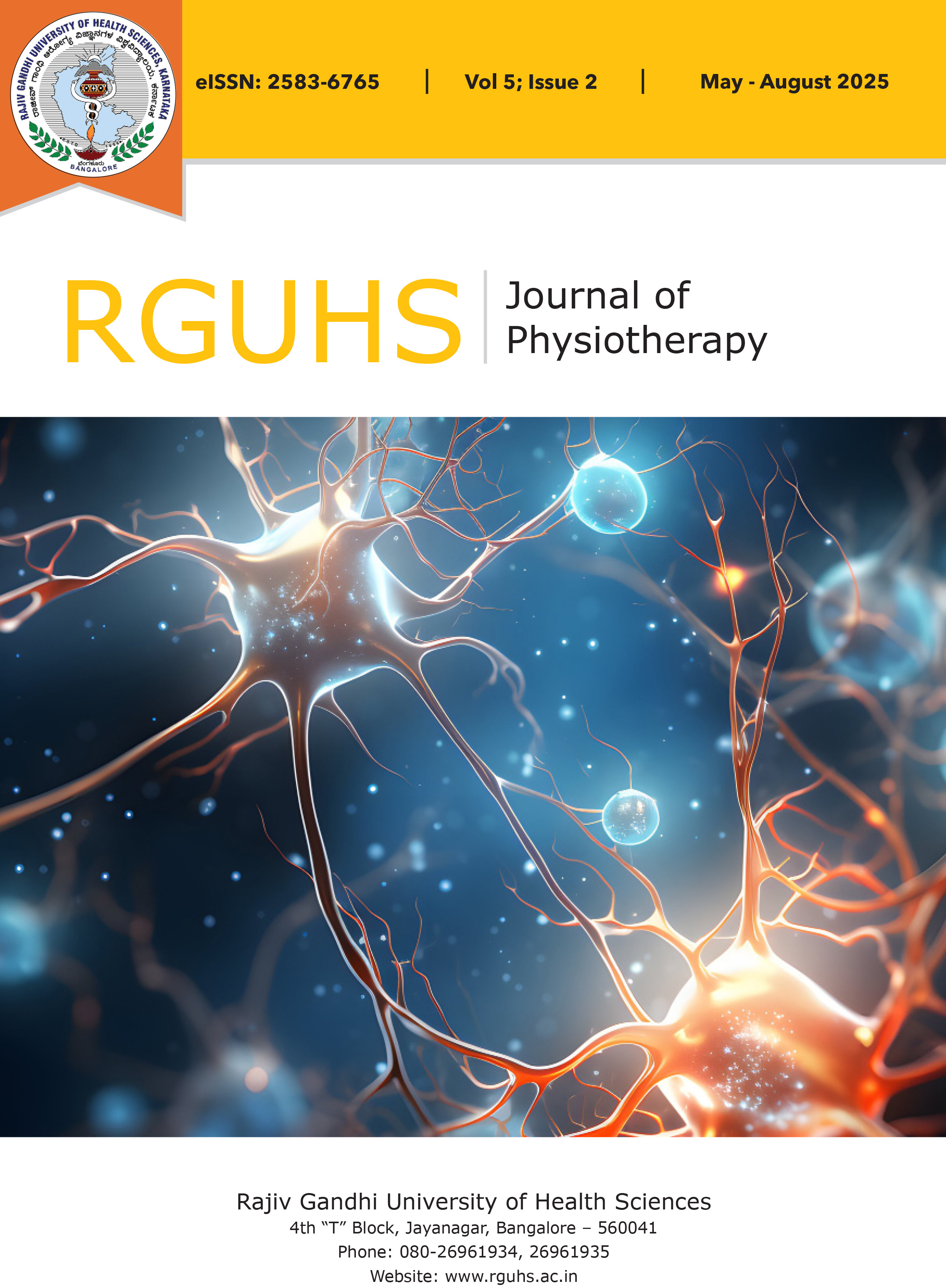
RGUHS Nat. J. Pub. Heal. Sci Vol No: 5 Issue No: 2 eISSN:
Dear Authors,
We invite you to watch this comprehensive video guide on the process of submitting your article online. This video will provide you with step-by-step instructions to ensure a smooth and successful submission.
Thank you for your attention and cooperation.
1Dr. Vijay Samuel Raj V, MPT, PhD, Professor, JSS College of Physiotherapy, Mysore, Karnataka, India E-mail: vijaysam_jsscpt@jssonline.org

Abstract
None
Keywords
Downloads
-
1FullTextPDF
Article
Competency-Based Medical Education (CBME) is an outcome-focused approach that uses a structured framework of competencies to design, implement, assess, and evaluate medical education. It emphasizes accountability, flexibility, and a learner-centered approach. While CBME has been widely adopted in medical education in India, both faculty and students face challenges in effectively delivering the content needed to achieve educational goals. To ensure that clinicians and physiotherapists are of high quality, it is essential to enhance training methods by incorporating effective teaching-learning strategies (TLM), evaluation programs, assessments, and feedback, all of which play a critical role in improving educational standards.
Competency-Based Education (CBE) focuses on outcomes, unlike traditional curricula, which primarily concentrate on content delivery. CBE is structured to develop the necessary competencies while employing a learner-centered approach. In particular, physiotherapy education involves building knowledge alongside strong skill development programs. The entry-level physio-therapy curriculum should be competency-based, as recommended by professional bodies. Therefore, competency-based physiotherapy education must provide learners with the experiences needed to develop essential competencies.
Are students and faculty equipped to meet these demands? Despite the numerous benefits and positive effects associated with CBE in physiotherapy, as emphasized by educators and scholars, it is crucial to address the challenges of effectively incorporating TLM methods. Faculty and students often rely on traditional teaching and learning methods, which can create obstacles to adopting innovative and creative teaching processes aligned with CBE recommendations. Traditional education tends to be teacher-cantered, time-bound and focused primarily on the cognitive domain of learning. These methods often include large group teaching (LGT) and structured lectures that may not fully engage students. A student’s attention span can vary based on age, motivation, mood, and the material’s perceived relevance. Additionally, how lessons are planned and delivered can hinder the learning process, as students have different learning styles.
To enhance the learning experience, it is essential to create a supportive learning environment and teaching plan that caters to the needs of both learners and instructors to achieve educational objectives. Physiotherapy competency-based education aims to prepare capable professionals through teaching that emphasizes skill development, clinical reasoning, and clinical decision-making. Traditional classroom teaching may not adequately meet these objectives.
It is time for institutions to provide extensive training for faculty and students on CBE and its applications. While there is a wealth of learning theories, there is often a gap in their application in daily practice. The use of frameworks like Bloom’s Taxonomy to establish specific learning objectives is still lacking among educators. There is a pressing need for assessment and reflection on how to integrate these skills into the CBE program.
I believe that training teachers and implementing effective curriculum delivery programs can significantly improve the application of CBE in physiotherapy.
Several components can be incorporated into TLM. Bloom’s Taxonomy framework is useful for creating educational goals through measurable learning outcomes, targeting the depth of learning that students need to achieve. Bloom’s Taxonomy includes three domains: Cognitive (knowledge-based), Affective (attitude-based), and Psychomotor (skill-based). TLM should encompass all these aspects to address the overall educational components. Additionally, it is important to consider the affective domain, which involves a student’s ability to engage, respond, demonstrate, integrate, and exhibit the required attitudes.
Teaching and learning methods could include small group teaching, Self-Directed Learning (SDL), demonstrations, buzz groups, brainstorming sessions, realistic learning scenarios, and flipped classroom models. Other effective strategies include debates, resource-based tasks, role-playing, simulations, Problem-Based Learning (PBL), and Case-Based Learning (CBL). In CBE, the teacher’s role shifts to that of a facilitator, guiding students as they progress toward achieving the desired competencies. Feedback should be an integral part of all teaching and learning activities to assess the effectiveness of TLM and to enhance teaching skills accordingly. The CBE in physiotherapy can be effectively achieved by appropriate lesson planning incorporating the teaching-learning methods and achieving institutional and learning objectives.
Are we adequately equipped with the knowledge necessary to effectively deliver the curriculum? It is essential to examine the possibility of incorporating Continuous Professional Education (CPE) at the postgraduate level, as well as considering its role at the undergraduate level. Additionally, we should evaluate whether the faculty possesses the required training for this delivery and whether the students are adequately prepared to engage with the material. How can we effectively implement CPE and outcome-based education at both the undergraduate and postgraduate levels?It is time to think critically and take action to ensure effective curriculum delivery and achieve our educational objectives, making the CPE practically implementable.
Supporting File
References
1. Ananthakrishnan, Nilakantan & K Raman, Sethuraman & Kumar, Santosh & K A, Narayan & Sridhar, Magadi. (2021). Medical Education - Principles and Practice Second Edition, 2000 NTTC, JIPMER.
2. Chatterjee S, Kar SK. Undergraduate Research Elective under Competency - Based Medical Education (CBME) in India: Challenges and Directions. Indian J Psychol Med 2023;45(5):548-51.
3. Swaminathan N. Physiotherapy Education in India: Is It Time for Reform? J Soc Indian Physiother 2021;5(2):35.
4. World Physiotherapy. Guidance for developing a curriculum for physiotherapist entry level education programme. London, UK: World Physiotherapy 2022.
5. Yadav V. Competency-Based Physiotherapy Education in Indian Context. J Med Pharm Allied Sci 2021;15:2846-51.